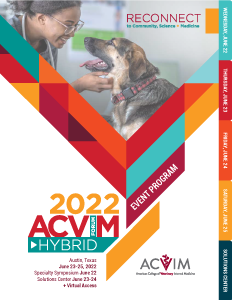Back
Please note, this session is not eligible for CE credit via on demand viewing. It is only available for CE credit if you attended the session live in person.
Research Abstract - Oral
Small Animal Internal Medicine
HM02 - Efficacy of Therapeutic Plasma Exchange (TPE) in Dogs with Immune-mediated Hemolytic Anemia: A Case-Controlled Study
Friday, June 24, 2022
8:15 AM – 8:30 AM CT
Location: ACC 17AB
CE: .25
.jpg)
Larry D. Cowgill, DVM, PhD, DACVIM (SAIM), President ACVNU
Professor and Associate Dean
School of Veterinary Medicine, Univ of California-Davis
Davis, California, United States
Research Abstract - Oral Presenter(s)
Abstract: Background--TPE has emerged as adjunctive therapy for severe IMHA in dogs but has not been compared to conventional therapy. We report the efficacy of adjunctive TPE to comparator dogs managed medically.
Hypothesis/Objectives—Effective TPE delivery improved survival in dogs with severe IMHA.
Animals--34 client-owned dogs with primary or secondary IMHA (HCT < 20%, spherocytosis, reticulocytosis, transfusion dependency, known outcome) treated with adjunctive TPE at UC Davis between 2010-2020 were compared to 72 similarly affected, randomly selected dogs managed medically over the same interval. Both cohorts were censored for euthanasia within 3 days for financial concerns yielding 32 TPE and 68 Control dogs.
Methods—100 TPE treatment were delivered on a Spectra Optia. Controls were managed with conventional immunosuppression. Kaplan-Meier (Logrank) survival analysis was compared between all TPE, dogs with ≥ 3TPE treatments, and Controls at 30 days.
Results—TPE dose was 1.4 ± 0.3 plasma volumes (PV)/session. 4/6 non-surviving dogs received ≤ 2 TPE treatments (2.0 ± 0.6 PV); 28 dogs received ≥ 3TPE treatments delivering 4.2 ± 0.6 PV/dog. 30-day survival for all TPE and medically managed dogs was 76.5% and 57.5%, respectively (P = 0.06). When censored for financial-directed euthanasia, survival for TPE and Control cohorts was 81.3% vs 61.8%, respectively (P = 0.058, Fig). Survival for dog receiving ≥ 3TPE ( > 4.0 PV delivered) was 92.9% vs Control (P = 0.003). Hazard ratio for Control/ ≥ 3TPE was 6.4.
Conclusions—Delivery of TPE ( > 4 total PV) was associated with improved survival in dogs with IMHA compared to medical management.
Hypothesis/Objectives—Effective TPE delivery improved survival in dogs with severe IMHA.
Animals--34 client-owned dogs with primary or secondary IMHA (HCT < 20%, spherocytosis, reticulocytosis, transfusion dependency, known outcome) treated with adjunctive TPE at UC Davis between 2010-2020 were compared to 72 similarly affected, randomly selected dogs managed medically over the same interval. Both cohorts were censored for euthanasia within 3 days for financial concerns yielding 32 TPE and 68 Control dogs.
Methods—100 TPE treatment were delivered on a Spectra Optia. Controls were managed with conventional immunosuppression. Kaplan-Meier (Logrank) survival analysis was compared between all TPE, dogs with ≥ 3TPE treatments, and Controls at 30 days.
Results—TPE dose was 1.4 ± 0.3 plasma volumes (PV)/session. 4/6 non-surviving dogs received ≤ 2 TPE treatments (2.0 ± 0.6 PV); 28 dogs received ≥ 3TPE treatments delivering 4.2 ± 0.6 PV/dog. 30-day survival for all TPE and medically managed dogs was 76.5% and 57.5%, respectively (P = 0.06). When censored for financial-directed euthanasia, survival for TPE and Control cohorts was 81.3% vs 61.8%, respectively (P = 0.058, Fig). Survival for dog receiving ≥ 3TPE ( > 4.0 PV delivered) was 92.9% vs Control (P = 0.003). Hazard ratio for Control/ ≥ 3TPE was 6.4.
Conclusions—Delivery of TPE ( > 4 total PV) was associated with improved survival in dogs with IMHA compared to medical management.

